Cable curls are among the most effective exercises for building the biceps. Unlike free-weight curls, cable bicep curls provide constant tension due to their more consistent resistance curve. They’re also far easier to set up for because you don’t need to load any weights onto the bar—you just slide the pin into the weight stack and lift.
As such, they make an excellent addition to any bicep strength training program irrespective of whether you want to get lean and toned or big and muscular.
Related: Bicep exercises for women
Cable curl exercise details
- Other Names: Cable straight bar curls, low cable curls
- Main Muscles: Biceps brachii
- Secondary Muscles: Brachialis, brachioradialis, forearm flexors
- Exercise Type: Strength
- Exercise Mechanics: Isolation
- Difficulty Level: Beginner
- Equipment Needed: Cable machine, straight bar attachment
How to do a cable bicep curl
- Position a pulley at the bottom of a cable machine and attach a straight bar to the clip.
- Grab the bar with a shoulder-width, underhand grip.
- Take one step away from the pulley to create some tension.
- Lift the bar up by flexing your elbows while keeping your shoulders still.
- Keep going until you feel an intense bicep contraction (until the angle at your elbows exceeds 90-degrees).
- Lower the bar under control until your elbows are fully locked out.
- Repeat for 3-4 sets of 8-20 reps.
Cable curl mistakes
Standing bicep cable curls are a simple exercise on the surface. But even as a straightforward isolation drill, many lifters still make these 5 form mistakes when performing bicep cable curls in the gym. If you can avoid these common pitfalls, then you’ll achieve greater muscle growth and reduce your injury risk because your reps will stimulate more hypertrophy.
Using momentum
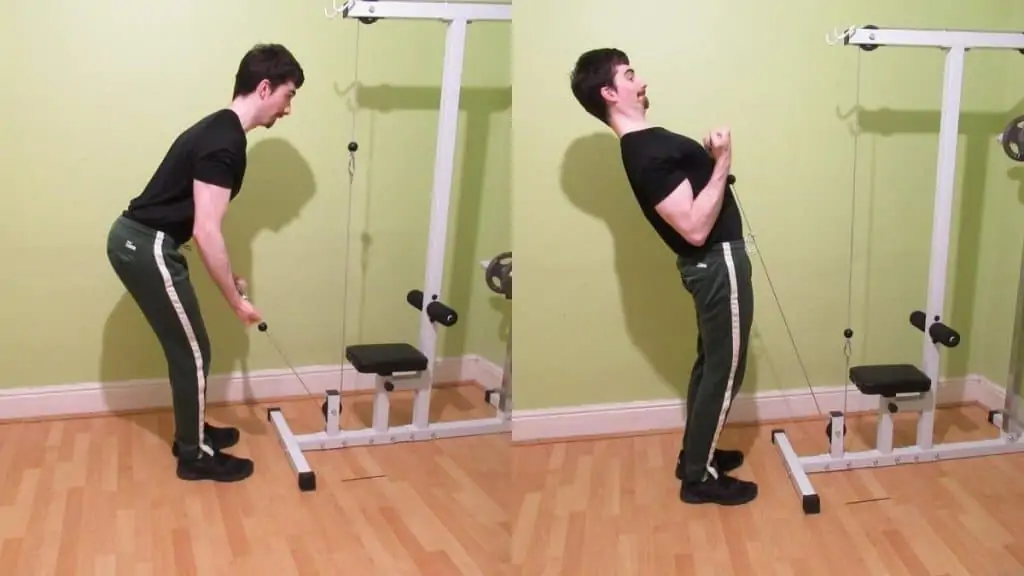
While cheat curls do have their place in some mass-building programs, the standing bicep cable curl is not the place where you want to be caught cheating on your curls. By generating momentum from your shoulders, knees, or hips, you’re taking tension off the target muscle and making the exercise less effective.
Not only that but because you generally have to lean back in order to cheat the weight up, you’re also putting extra pressure on your spine, which could potentially lead to a severe injury if the cheating is excessive.
That said, a small amount of shoulder movement is fine. After all, the biceps weakly assist with shoulder flexion (as in a front raise). [1] So you can certainly let your shoulders travel forward slightly without compromising the movement.
Just make sure to keep this exercise a bicep cable curl. While your legs and core should certainly be tight and stable so that you can generate power, your arms should do virtually all of the lifting.
Performing partial reps

Again, partial reps have their place in a well-rounded cable biceps workout because they can help to recruit the remaining muscle fibers at the end of a session.
But as the years go by, the science is becoming more clear: Full reps result in more hypertrophy than partial reps. [2]
So if you want to maximize your bicep growth (who doesn’t?), then make sure to always use a full range of motion when doing a standing cable curl.
An excellent way to drill this principle into your technique is to purposefully flex your triceps at the bottom of every rep. This ensures that your biceps are fully lengthened, which in turn means that you’re attaining a full stretch.
Just be sure to get a proper contraction at the top of the rep, too. Aim to bring the bar above where your upper and lower arms form a 90-degree angle for the strongest peak contraction.
Related post: Cable curl alternative
Exaggerating your grip
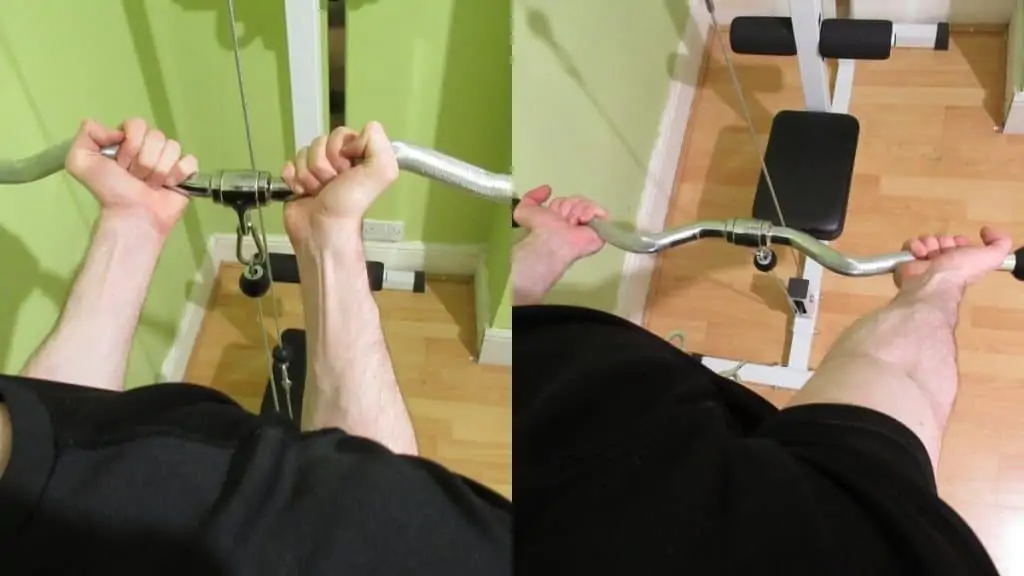
Close grip cable curls are a good exercise for emphasizing the long (outer) head of your biceps. However, standard straight bar cable curls are more suited to building overall muscle mass because they enable you to lift more weight than other cable curl variations.
So by using excessively close or wide grips, you’re putting certain parts of your biceps at a mechanical disadvantage and are thus limiting their ability to produce force. Ultimately, by making your biceps weak in a bid to emphasize certain heads, you may actually be reducing your overall muscle development.
Instead, hold the straight bar with a shoulder width grip and keep your elbows comfortably pinned to the sides of your body.
Flexing your wrists

You should perform low pulley curls with neutral or slightly extended wrists to take tension off your forearms and redirect it to your biceps. Unfortunately, most lifters don’t do this. And you might not even realize that you’re making this mistake until you take a look at your form!
This pitfall most commonly occurs during the concentric (lifting) phase of the rep because it’s the most challenging part of the repetition, and so it’s tempting to let your forearms help your biceps out.
Avoid this temptation.
Instead, make an extra effort to maintain neutral or slightly extended wrists while curling so that you can direct the most tension towards your biceps. It may also help to hold the bar with a looser grip so that your forearm muscles aren’t as active.
Standing too far away from the pulley
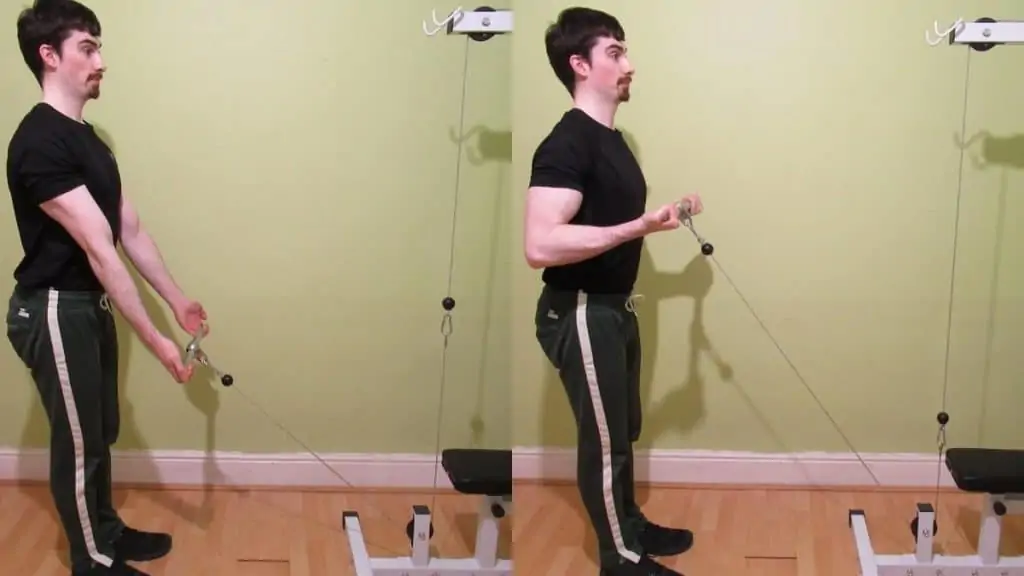
The further that you walk the cable away from the pulley, the more your core has to resist the tension. So, in order to keep the standing straight bar cable curl an isolation exercise, limit yourself to 1-2 small steps away from the lower pulley. This way, you can focus 100% of your attention on blasting your biceps rather than on making sure that you don’t get dragged towards the machine like metal getting slammed to a magnet.
For some comparisons, check out our cable curls vs dumbbell curls guide to learn the difference between these two popular exercises. Our cable curl vs barbell curl article is very similar; the main difference is that the barbell version is more challenging and allows for heavier weights to be lifted.
Cable curl variations
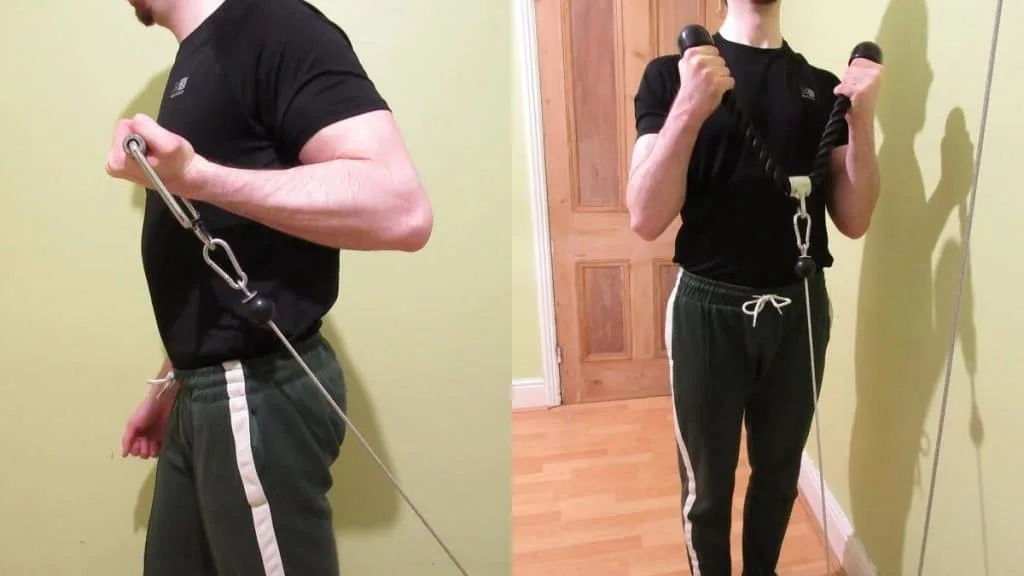
Straight bar cable curls really work the biceps because they provide constant tension and enable you to lift heavier weights than most other variations. Yet, if you want to emphasize different parts of your biceps or increase the variety in your workout routine, then it’s a good idea to perform one or more of these different bicep curls in addition to regular biceps cable curls.
- Rope hammer curls
- High cable curl
- Behind the back cable curl
- Single arm cable curl
- Reverse cable curl
- Guillotine curl
- Lying cable curl
- Seated cable curls
- Bayesian curl
- Cable preacher curl
- EZ bar cable curl
- Incline cable curl
- Cable concentration curls
- Cable drag curls
- Cable spider curl
- Behind the head cable curl
- Close grip cable curls
- Alternating cable curls
- Wide grip cable curl
- Zottman cable curl
Cable bicep curl FAQ
What are the benefits of the cable biceps curl?
Unlike its free-weight counterparts, the cable bar curl makes your biceps work harder because it provides constant tension. In other words, you can’t just rest at the bottom of the rep like you can with regular weighted curls because the pulley is constantly exerting a force on your biceps.
The cable barbell curl is also a very joint-friendly exercise because the pulley stabilizes some of the weight for you. This means that the cable doesn’t sway from side to side like dumbbells can do. As such, your connective tissue structures naturally get subjected to less stress, which can help to reduce your chance of getting wrist and elbow injuries.
How many sets of standing cable bicep curls should you do?
The optimal number of sets for low cable bicep curls depends on your training status (beginner, intermediate, etc.) and your level of commitment.urls should you do?
For example, if you’re a novice lifter, then you can make great gains from doing just 2-3 sets of cable arm curls per workout (1-2 times per week).
On the other hand, if you’re more advanced, you’d likely progress better from performing 4-5 sets per session because the bigger your arms get, the more volume they can tolerate.
What’s the optimal rep range for the straight bar cable curl?
Since low pulley cable curls provide such a remarkable muscle pump, many lifters like to perform sets of 15-20 reps to really feel the burn in their biceps.
This approach is an excellent one. Yet, you can also perform sets of 6-10 reps and still see comparable results.
Higher reps are easier on your joints because you’re lifting less weight, and they also enable you to accumulate training volume (reps x sets x weight) faster than lower reps. So unless you want to spend ages resting in order to lift heavy weights for 6-8 reps, your best bet is to stick to sets of 12-20 reps on your cable barbell curls.
Save the really heavy lifting for your free weight work or chin-ups.
How many times a week should you do the low pulley cable curl?
Perform the biceps cable curl once per week if you’re a novice lifter. Why not more often?
When you’re new to the gym, protein synthesis, the chemical reaction that’s responsible for hypertrophy, is elevated for an entire week. So there’s no real advantage to training your biceps more often, especially if they’re not yet recovered.
If you’re an intermediate or advanced lifter, then you can perform cable machine bicep curls 2-3 times per week and see excellent results. There are even cases of people using training frequencies of 4-7 times per week, but these should be reserved for truly elite lifters.
Read More: Chest and bicep workout │Biceps supersets
The verdict on cable curls
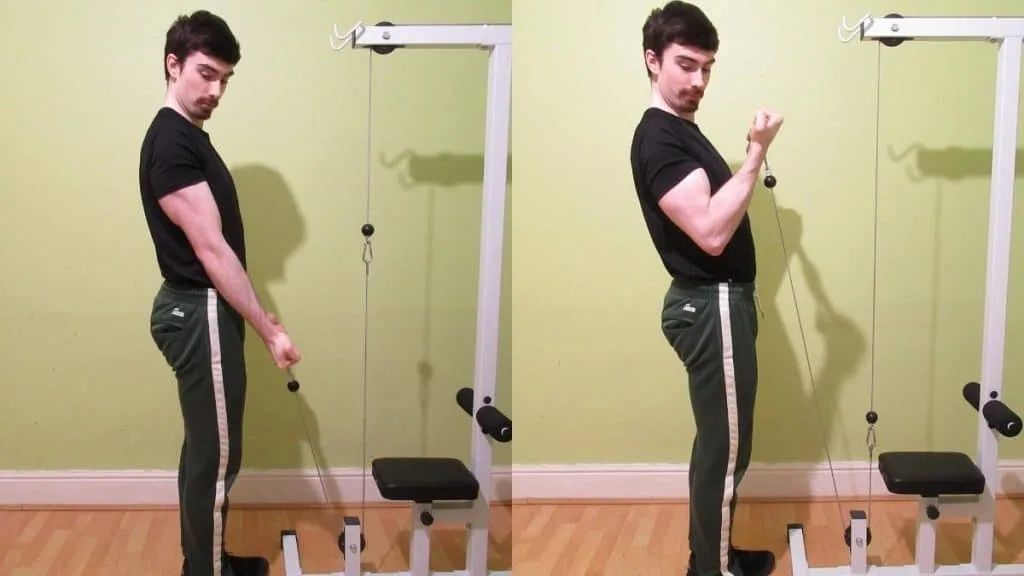
Cable curls have many advantages over traditional bicep curls. First off, they save you time and effort because they’re easier to set up. This makes them ideal if you train in a busy gym or just have a hectic schedule.
The cable bicep curl also provides constant tension because as soon as you lift the weight stack, your muscles have to contract against resistance. This results in a more potent muscle pump and more efficient training because every part of the repetition is highly effective.
Consider beginning your workout with heavier free weight exercises for developing overall arm mass. This way, your core muscles and central nervous system will be at their freshest and capable of lifting maximum weight.
Since standing cable curls are relatively straightforward to execute, you can perform them close to the end of your training session without seeing much of a degradation in technique. For this reason, they’re also one of the most effective bicep exercises for beginners to build muscle.
References
- Landin, D., Thompson, M., & Jackson, M. R. (2017). Actions of the Biceps Brachii at the Shoulder: A Review. Journal of Clinical Medicine Research, 9(8), 667–670. https://doi.org/10.14740/jocmr2901w
- Pinto, R. S., Gomes, N., Radaelli, R., Botton, C. E., Brown, L. E., & Bottaro, M. (2012). Effect of Range of Motion on Muscle Strength and Thickness. Journal of Strength and Conditioning Research, 26(8), 2140–2145. https://doi.org/10.1519/jsc.0b013e31823a3b15

